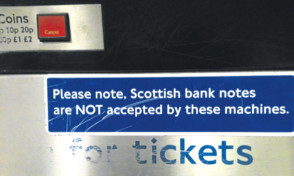
At London’s Liverpool Street station last weekend I was confronted by the sign below, which boldly states: “Scottish bank notes are not accepted by these machines.”
I looked at the queue for the ticket office a mile long. And the queue for the bank card-accepting machines not much shorter. So I took out my mobile, snapped a picture and sent it out on Twitter saying: “The classic London greeting at Liverpool St Station Underground. But why do we tolerate it?”
Then the Twitter storm began!
“Anti-English rot. Grievance politics. The classic London greeting? Really? Amazing that so many Scots thrive among us dreadful people. I assume you are willing to bear all the extra costs. Or will Scotland impose those on the rest as usual? Do you want to stick euros/dollars/yen in machines too?”
Of course all that triggered a robust Scottish response.
“It’s an outrage. Just don’t pay. I make sure I ONLY have Scottish notes when travelling south more fun! Let’s refuse English banknotes in Scotland so they can see what it feels like?”
Oh dear.
Soon an ordinary grumble about basic equality in the UK had become border warfare. But why do we put up with it?
Traders and ticket machines have been rejecting Scottish money in England for yonks. It’s why many of us change notes before heading south albeit with gritted teeth.
Why? Well in 1826, Westminster passed legislation preventing banks from issuing their own pound notes, as the practice was threatening to get out of hand. But a vigorous campaign spearheaded by Sir Walter Scott won Scotland an opt-out. So three banks retain the right to print their own money, the RBS, the Bank of Scotland and the Clydesdale. Which is fine, as long as those notes stay north of the border.
According to the Bank of England website, Scottish notes are not legal tender in England nor are Bank of England notes outside England and Wales! It states: “The acceptability of a Scottish or Northern Ireland note is a matter for agreement between the parties involved. If both parties agree, Scottish and Northern Ireland notes can be used in England and Wales.”
But you cannae agree or disagree with a machine!
So how does London Underground explain its stance? Ticket machines at Scottish stations cope with Scottish and English notes. The big supermarkets in London handle Scottish and Northern Irish notes in their auto checkouts. Is it so hard for the Tube to update its software? I asked but got no reply. You expect more from a public body because it sets an example for others.
And avoids a basic political truth. The UK is composed of four nations of which three have their own banknotes. Is that so hard for everyone to accommodate?
Don’t just blame London. Some Scots reject Northern Irish banknotes, too!
A solution was suggested six years ago by Orkney and Shetland MP Alistair Carmichael, now the Scottish Secretary. He suggested Scottish banknotes should be legally protected in England to stop them being rejected.
“Scots in England have no legal recourse when their banknotes are refused, leading to embarrassment and irritation. This is the result of historic accident and it’s time to address it.”
Then Alistair was only Lib Dem Scottish spokesperson. Now he has a lot of clout.
So gaun, Big Al. If you can fix this, your kipper should adorn the next Scottish fiver.
Is it a deal?

Enjoy the convenience of having The Sunday Post delivered as a digital ePaper straight to your smartphone, tablet or computer.
Subscribe for only £5.49 a month and enjoy all the benefits of the printed paper as a digital replica.
Subscribe